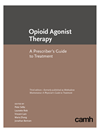Text adapted in 2023 from "Opioid Use and Opioid Use Disorders" in The Primary Care Addiction Toolkit. Revised version available online only.
Prescribing opioids to patients with opioid use disorder and chronic non-cancer pain can be effective, but requires careful controls and monitoring (Chelminski et al., 2005; Jamison et al., 2010; Manchikanti et al., 2006a, 2006b; Wiedemer et al., 2007). The evidence supporting continued opioid prescribing in this population has significant limitations because the interventions were conducted in multidisciplinary clinics with nurses, internists and pharmacists, not in primary care settings. The studies also had high dropout rates.
Initial opioid prescribing should be considered a time-limited therapeutic trial (e.g., three to four months) to determine whether it is effective before continuing.
If the patient does not adhere to treatment or continues aberrant behaviours that suggest an opioid use disorder, discontinue prescribing, begin tapering or refer the patient for opioid agonist therapy (OAT) with methadone or buprenorphine. Buprenorphine may manage pain in patients who report severe pain on high doses of full opioid agonist medications. Split dosing of buprenorphine may be adequate to manage chronic pain in patients with opioid use disorder. However, it should only be considered if all other non-opioid treatments are ineffective or inappropriate (Busse et al., 2017).
Although patients on OAT may be prescribed opioids to manage severe acute pain, opioids are generally not prescribed for chronic non-cancer pain in patients on OAT. Instead, refer them or request guidance from an addiction medicine specialist who has experience managing pain in patients who have an active substance use disorder. Addiction medicine physicians can provide assessment, advice, follow-up and referral for this population. They may also initiate treatment with methadone or buprenorphine.
Comprehensive pain clinics have pain experts, mental health professionals and sometimes addiction experts. They use various strategies, including cognitive therapy, pharmacotherapy and physical modalities. Unfortunately, access to comprehensive pain clinics is limited in many regions.


